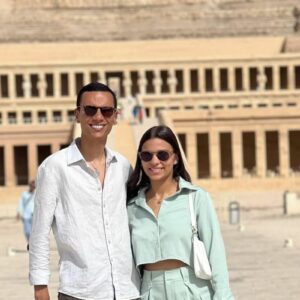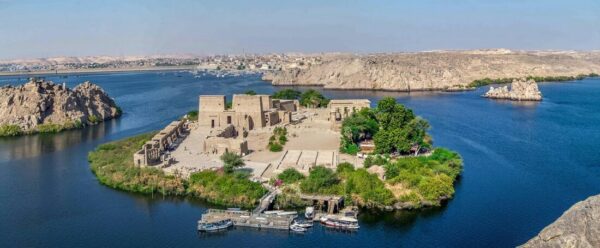King Tutankhamun
King Tut is one of the pharaohs of the Eighteenth Egyptian Dynasty in the history of ancient Egypt, and his name in the ancient Egyptian language means the living image of the god “Amun,” the chief ancient Egyptian god.
King Tutankhamun is the son of king “Akhenaten” or (Amenhotep IV). Studies have proven through DNA that King Tutankhamun is the son of King “Akhenaten” .
King Tutankhamun was nine years old when he became Pharaoh of Egypt. Pharaoh Tutankhamun lived a transitional period in the history of ancient Egypt, where King Tutankhamun came. After King Akhenaten, who tried to unify the gods in the form of one. During the reign of King Tutankhamun, there was a return to the worship of multiple gods in ancient Egypt.
He married Queen Ankhes Amun. Tutankhamun is considered one of the most famous pharaohs for many reasons, including the discovery of his entire tomb and treasures without any damage.
The mystery surrounding the circumstances of his death, as many considered the death of a Pharaoh at a very young age to be unnatural, especially with traces of fractures in the thigh bone and skull and the marriage of a minister to his widow, “Ankhes Amun” after his death. All of these mysterious events raise doubt about the cause of the death of the Pharaoh “Tut Ankh Amoun”.
The reign of Pharaoh Tutankhamun:
The reign of Pharaoh Tutankhamun did not exceed 10 years, but he carried out many works, such as repairing the statues and columns of the Karnak Temple, and he also created the sacred boats, and built the Palace of the Years on the West Bank, which is now considered another mystery as its location has not been found. Until now, just as the men of the court and those in charge of the affairs of the country during the reign of Tutankhamun worked to save the country and advance it, they worked to restore the course of normal life to it. They restored the worship of the ancient gods and saved the country from the sad religious chaos. Tut ankh Amun did not forget to restore Manifestations of the ancient religion go back to the Luxor Temple, so return the name of the god Amun, which Akhenaten removed.
Reasons for the death of King Tutankhamun:
The death of King Tutankhamun was suspicious, and it was likely that he did not die naturally, but was assassinated, but as a result of the three-dimensional computer imaging, there is no evidence that King Tutankhamun was subjected to an assassination, and that the hole in the skull was not caused by a blow, but rather For the purpose of mummification, the hole in the left thigh was the result of a fracture suffered by King Tutankhamun before his death. The final report on the cause of death was blood poisoning as a result of a fractured thigh.
In another study, it was said that the cause of death was malaria.
Discovery of Tutankhamun’s tomb:
The Valley of the Kings was a cemetery for the pharaohs of that period. In this rocky valley, which has an area of approximately 20,000 square metres, it contains 27 royal tombs belonging to three families: the Eighteenth Dynasty, the Nineteenth Dynasty, and the Twentieth Egyptian Dynasty.
The construction of the pharaoh’s tomb usually began days after he was appointed pharaoh of Egypt, and construction often took decades, as they used simple tools in construction.
On November 4, 1922, when the British archaeologist and specialist in the history of ancient Egypt, called “Howard Carter,” was excavating at the entrance to the tunnel leading to a tomb of Ramesses VI in the Valley of the Kings noticed the presence of a large tomb and continued his careful excavation until he entered the room containing the body of King Tutankhamun.
On the walls of the room containing King Tutankhamun were wonderful drawings that told in the form of the story of King Tutankhamun’s departure to the dead, and a scientist noticed Antiquities Howard Carter: There was a wooden box with inscriptions inlaid with gold in the middle of the room. When he lifted the box, he noticed that the box covered a second box decorated with inscriptions inlaid with gold, and the second box was covered with a box.
The third was inlaid with gold, and after that he reached the stone sarcophagus, which was covered with a thick layer of carved stone in the shape of a statue.
The golden coffin was covering two other golden coffins in the form of statues of the young pharaoh. The archaeologist found difficulty in lifting the third shroud that was covering the mummy of Tutankhamun. The archaeologist exposed the shroud to the heat of the blazing summer sun in order to separate the golden shroud from the mummy, but the attempt failed. The golden shroud was cut into two halves and arrived at Tutankhamun’s mummy with all its adornments, including necklaces, rings, crowns, and staffs, all of which were made of pure gold.
Egypt Tours to King Tutankhamun Tomb in Valley of the kings
-
From $1440 🎗 10% OFFAswan, Cairo, Egypt, Luxor

 Sale! Add to cart
7 Days Deluxe Nile cruise + Domestic Flights
Sale! Add to cart
7 Days Deluxe Nile cruise + Domestic Flights7 Days Tour To Egypt with Cairo, Aswan, Luxor, and Nile Cruise
Rated 5.00 out of 5Nile Cruise$2,000.00$1,600.007-Days Tour To Egypt with Cairo, Aswan, Luxor, and Nile Cruise Egypt Cruis Era provides you with a 7 days tour to Egypt that covers the essentials of Cairo, Aswan, Luxo -
Why you’ll love this trip: Sail along River Nile over 5 days Explore and relax on 5 days’ trip to cover the sights in Luxor, Aswan, Edfu and Kom Om
-
From $295 🎗 0% OFFLuxor, Sharm El Sheikh

 Sale! Add to cart
10 Hours Deluxe Nile cruise + Domestic FlightsWhy you’ll love this trip: Take a day trip from Sharm El Sheikh to Luxor, a city with a high concentration of ancient te
Sale! Add to cart
10 Hours Deluxe Nile cruise + Domestic FlightsWhy you’ll love this trip: Take a day trip from Sharm El Sheikh to Luxor, a city with a high concentration of ancient te -
From $1440 🎗 10% OFFAbu Simbel, Aswan, Cairo, Egypt, Luxor

 Sale! Add to cart
10 Days Deluxe Nile cruise + Train
Sale! Add to cart
10 Days Deluxe Nile cruise + TrainThe Classic 10 Days Egypt Tour Package with Cairo and Nile Cruise
Rated 5.00 out of 5Cairo and Abu Simbel Tour packages$2,100.00$1,600.00With our Classic 10 Days Egypt Tour Package, you will embark on a five-star Egyptian adventure. Stay in one of Cairo hotels, cruise the Nile River in a 5-star Nile cruise -
From $1575 🎗 0% OFFAbu Simbel, Aswan, Cairo, Edfu, Kom Ombo, Luxor

 Sale! Add to cart
7 Days Deluxe Nile cruise + Domestic Flights
Sale! Add to cart
7 Days Deluxe Nile cruise + Domestic Flights7 Day Cairo, Alexandria, Luxor, Edfu, Kom Ombo, Aswan and Abu Simbel
Rated 5.00 out of 5Egypt Tour Packages$3,500.00$2,800.00Why you’ll love this trip: Explore the great and historical Egypt including: Cairo, Alexandria Luxor, Edfu, Kom Ombu, Aswan & Ab








